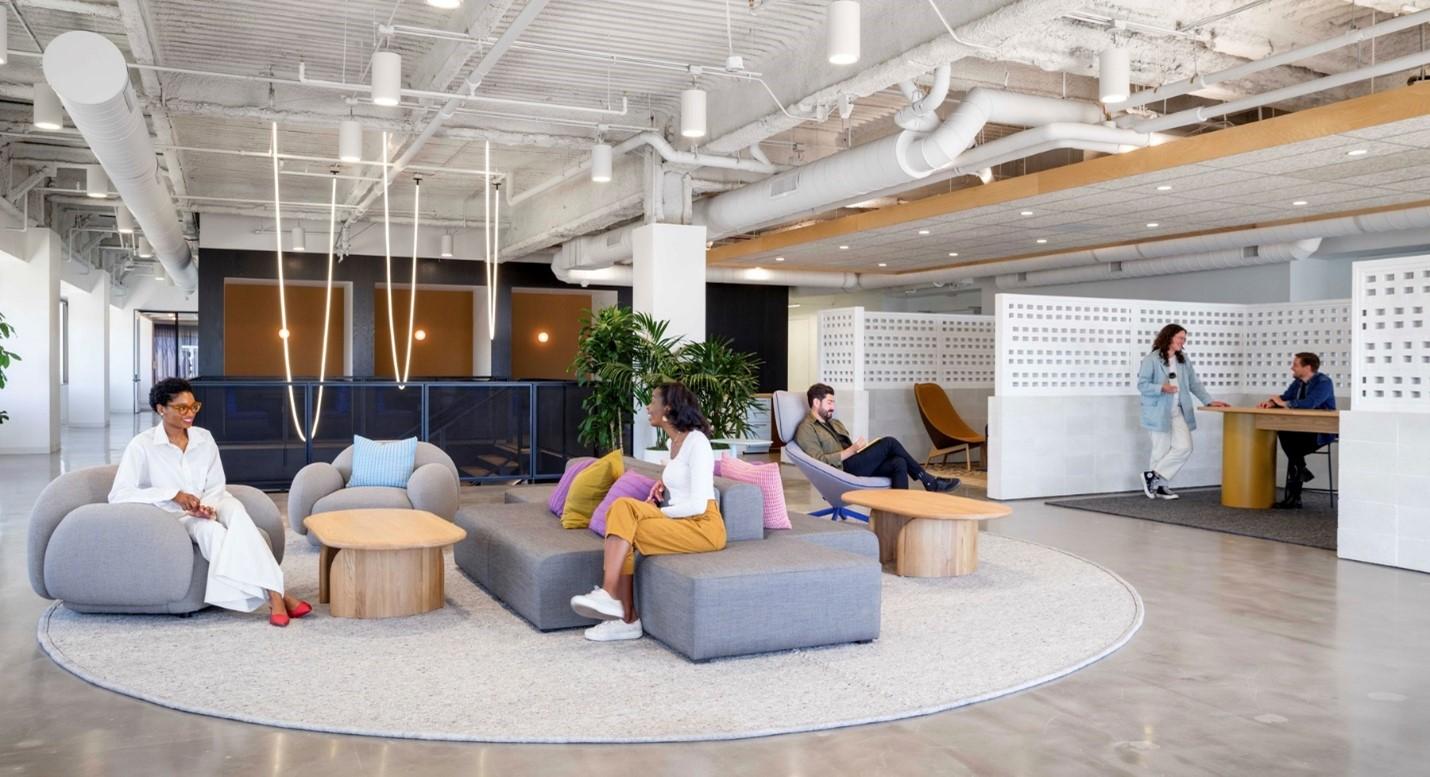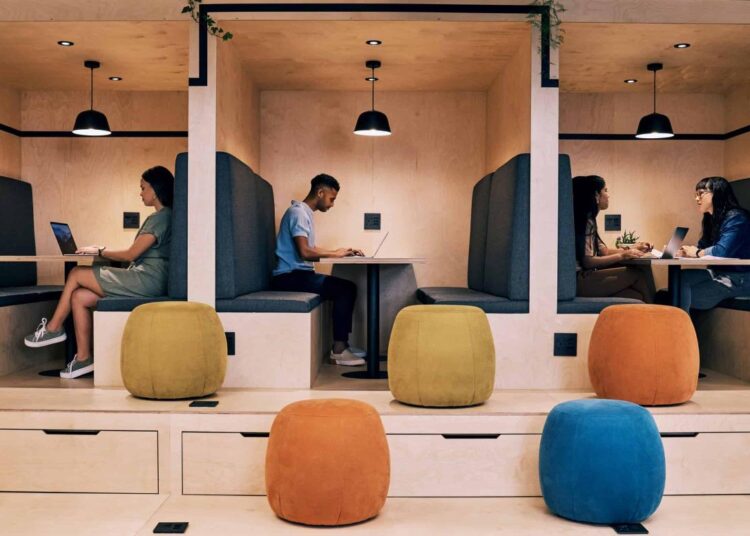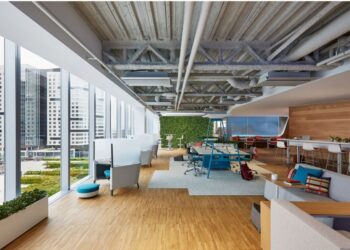The Genesis of Hybrid Work

The rapid embrace of hybrid work models isn’t a fleeting trend but a fundamental re-evaluation of workplace strategy. Several powerful forces have converged to make this blended approach the preferred model for countless organizations worldwide.
A. Technological Empowerment:
A. Ubiquitous Connectivity: High-speed internet access, robust Wi-Fi, and 5G networks have made working from virtually anywhere a seamless reality. This pervasive connectivity is the bedrock upon which hybrid models are built, enabling real-time communication and collaboration regardless of physical location.
B. Advanced Collaboration Tools: Cloud-based platforms, video conferencing software (Zoom, Microsoft Teams, Google Meet), digital whiteboards, and project management tools have become incredibly sophisticated. These technologies facilitate effective teamwork, brainstorming, and project execution even when team members are geographically dispersed.
C. Remote Access Infrastructure: Secure VPNs, virtual desktops, and cloud-based applications allow employees to access company resources and perform their tasks securely and efficiently from home or any other remote location, replicating the office environment digitally.
B. Shifting Employee Expectations and Well-being:
A. Demand for Flexibility: The workforce, particularly younger generations, increasingly values flexibility and autonomy over rigid schedules and commuting. Hybrid models offer a better work-life balance, allowing individuals to integrate personal commitments more seamlessly with professional responsibilities.
B. Increased Productivity and Focus: Many employees report higher levels of focus and productivity when working remotely, free from office distractions. Conversely, the office provides opportunities for social interaction and spontaneous collaboration that remote work often lacks. Hybrid models aim to capture the best of both.
C. Reduced Commute Stress: Eliminating or significantly reducing daily commutes saves time, money, and reduces stress, contributing to improved employee well-being and reducing environmental impact.
D. Enhanced Well-being: The ability to tailor one’s work environment (quiet at home, social at the office) leads to greater comfort, reduced burnout, and improved mental health, fostering a more sustainable working life.
C. Economic and Business Agility:
A. Optimized Real Estate Utilization: For organizations, hybrid models can lead to significant cost savings by optimizing office space. Instead of a 1:1 desk-to-employee ratio, companies can adopt flexible seating (hot-desking, hotelling), reducing their overall physical footprint and associated rental, utility, and maintenance costs.
B. Access to Wider Talent Pools: By not being restricted by geographic location, companies can recruit talent from anywhere in the world, accessing a more diverse and specialized workforce. This expands recruitment reach and reduces competition for local talent.
C. Increased Business Resilience: As demonstrated by recent global events, hybrid models provide inherent flexibility and business continuity. Organizations can quickly pivot between in-office and remote operations in response to unforeseen disruptions, ensuring continued productivity.
D. Enhanced Agility: Hybrid teams can often be more agile, able to respond quickly to market changes or project demands by leveraging diverse work locations and collaborative tools.
Defining the Hybrid Workspace
A successful hybrid workspace is more than just a policy; it’s a meticulously designed ecosystem that supports fluid movement between physical and virtual environments.
A. Flexible Physical Office Spaces
The office is no longer solely a place for individual work but a hub for connection, collaboration, and culture.
A. Activity-Based Working (ABW): Instead of assigned desks, the office offers a variety of zones tailored to different work activities.
A. Focus Zones/Quiet Rooms: Designated areas, often soundproofed, for deep concentration, individual work, or private calls. These provide a much-needed respite from open-plan areas.
B. Collaboration Hubs: Flexible spaces with movable furniture, whiteboards, and integrated tech for team meetings, brainstorming sessions, and project work. These can range from small huddle rooms to larger, reconfigurable areas.
C. Social Zones: Vibrant common areas like cafes, lounges, and communal kitchens designed for informal interactions, networking, and building team camaraderie.
D. Meeting Suites: Equipped with advanced audio-visual (AV) technology to facilitate seamless hybrid meetings, ensuring remote participants feel fully included.
B. Hot-Desking and Hotelling: Strategies for maximizing space utilization where employees do not have fixed desks.
A. Hot-Desking: Employees choose an available desk upon arrival, often supported by desk-booking apps.
B. Hotelling: Employees reserve a specific workstation or office in advance, providing more predictability. This often comes with personal locker facilities.
C. Modular and Adaptable Furniture: Furniture on wheels, movable partitions, and reconfigurable seating allow for quick changes to the layout to suit evolving needs, from large workshops to quiet individual work.
D. Designated “Arrival” Zones: Spaces designed for employees to transition into the office, offering lockers, charging stations, and easy access to booking systems.
B. Robust Digital Infrastructure
Seamless connectivity and powerful tools are non-negotiable for hybrid success.
A. High-Speed Network: Reliable and fast Wi-Fi across the entire office, with ample bandwidth to support simultaneous video calls and cloud operations.
B. Advanced Video Conferencing: Every meeting room, from huddle rooms to large boardrooms, must be equipped with high-quality cameras, microphones, and intelligent speaker tracking to ensure clear communication between in-person and remote participants.
C. Cloud-Based Collaboration Platforms: Tools like Microsoft 365, Google Workspace, Slack, Asana, and Miro are essential for document sharing, real-time editing, communication, and project management.
D. Secure Remote Access: Robust VPNs, multi-factor authentication, and secure cloud environments ensure employees can access company resources safely from anywhere.
E. Digital Whiteboards and Interactive Displays: Technologies that allow both in-person and remote team members to collaborate visually and in real-time.
F. Room and Desk Booking Systems: Intuitive apps or physical displays that allow employees to easily find and reserve available workspaces and meeting rooms.
C. Smart Office Technology
Leveraging IoT and AI to enhance the physical environment.
A. Occupancy Sensors: Monitor space utilization in real-time, providing data for optimizing layouts, cleaning schedules, and energy consumption.
B. Environmental Controls: Smart thermostats, lighting, and air quality monitors that automatically adjust settings based on occupancy, time of day, and user preferences, enhancing comfort and efficiency.
C. Wayfinding Systems: Digital signage and mobile apps that help employees navigate the dynamic office environment and find colleagues or meeting rooms.
D. Integrated Security: Smart access control systems, visitor management, and surveillance that can be managed remotely.
D. Clear Policies and Culture
Technology and space are only part of the equation; cultural alignment is paramount.
A. Defined Work Models: Clearly articulated policies regarding in-office days, remote work expectations, and core collaboration hours.
B. Equitable Participation: Strategies to ensure remote employees have an equal voice and equal opportunities as their in-office counterparts, preventing “proximity bias.”
C. Communication Protocols: Guidelines for how and when to use different communication channels (e.g., Slack for quick questions, email for formal announcements, video calls for discussions).
D. Focus on Outcomes: Shifting from a “time in office” mentality to measuring productivity based on deliverables and results.
E. Leadership Modeling: Management actively demonstrating and championing the hybrid work model, utilizing the flexible spaces and tools.
The Multifaceted Benefits of Hybrid Workspaces

The strategic adoption of hybrid models brings a wealth of advantages for both organizations and their employees, far beyond mere cost savings.
A. Enhanced Employee Satisfaction and Well-being
A. Improved Work-Life Balance: Flexibility allows employees to better manage personal appointments, family responsibilities, and hobbies, leading to reduced stress and burnout.
B. Increased Autonomy: Giving employees choice over where and when they work boosts morale, job satisfaction, and a sense of ownership over their work.
C. Reduced Commute Burden: Less time spent commuting translates to more personal time, less stress, and financial savings on transportation.
D. Better Focus and Productivity: Individuals can choose the environment (quiet home, collaborative office) that best suits their task, optimizing their ability to concentrate and produce high-quality work.
E. Access to Diverse Environments: The option to switch between home and office provides variety and can combat monotony, leading to increased creativity and engagement.
B. Optimized Organizational Performance
A. Increased Talent Pool: Companies are no longer limited by geographic boundaries, allowing them to recruit the best talent from anywhere in the world, leading to a more diverse and skilled workforce.
B. Reduced Real Estate Costs: By implementing flexible seating strategies, organizations can significantly reduce their office footprint, leading to substantial savings on rent, utilities, and maintenance.
C. Improved Retention Rates: Employees who feel valued and have flexibility are more likely to stay with their organization, reducing recruitment and training costs.
D. Enhanced Business Agility and Resilience: The ability to pivot quickly between in-office and remote work ensures business continuity during unforeseen disruptions (e.g., natural disasters, pandemics).
E. Increased Innovation: Diverse teams, empowered by flexible collaboration tools and environments, often lead to more innovative solutions and ideas.
F. Better Space Utilization: Data from occupancy sensors allows organizations to understand how their space is actually used, informing future design and optimization.
C. Environmental and Societal Impact
A. Reduced Carbon Footprint: Fewer commutes translate to lower greenhouse gas emissions from transportation. Optimized office energy consumption also contributes to a greener footprint.
B. Decreased Traffic Congestion: Less commuting alleviates traffic, reducing air pollution and stress in urban areas.
C. Revitalization of Suburban/Rural Areas: A distributed workforce can lead to increased economic activity and vitality in areas outside traditional city centers.
D. Greater Inclusivity: Hybrid models can make employment accessible to a wider range of individuals, including those with mobility challenges, caregiving responsibilities, or those living in areas with limited job opportunities.
D. Stronger Culture and Collaboration (When Managed Effectively)
A. Purposeful In-Office Days: When employees do come to the office, it’s often for specific, high-value activities like team building, strategic planning, or intensive collaboration, making in-person interactions more meaningful.
B. Stronger Connections: Hybrid models can encourage more intentional, high-quality interactions when teams are together, fostering deeper bonds.
C. Democratized Communication: Effective hybrid communication strategies ensure that remote voices are heard and included, leveling the playing field.
Implementing Hybrid Work
While the benefits are compelling, successfully implementing a hybrid model is not without its complexities. It requires foresight, investment, and continuous adaptation.
A. Managing Proximity Bias and Inclusivity
A. Risk: In-office employees might inadvertently receive more opportunities, recognition, or face-time with leaders, marginalizing remote colleagues.
B. Solution: Implement strict guidelines for hybrid meetings (e.g., everyone on camera, even in-office participants use individual laptops), ensure equal access to information, actively solicit input from remote team members, and train managers to lead inclusively.
B. Maintaining Culture and Cohesion
A. Risk: Lack of informal interactions can lead to a fragmented culture and weaker team bonds.
B. Solution: Plan regular in-person “all-hands” or team-building events, create dedicated social zones in the office, encourage virtual social activities, and foster intentional “water cooler” moments online.
C. Cybersecurity and Data Privacy
A. Risk: A distributed workforce can increase cybersecurity vulnerabilities, especially with personal networks and devices.
B. Solution: Implement robust VPNs, multi-factor authentication, secure cloud storage, provide cybersecurity training to all employees, and ensure all devices meet security standards.
D. Technology Investment and Integration
A. Risk: Inadequate or disjointed technology can lead to frustration, inefficiency, and a poor hybrid experience.
B. Solution: Invest in high-quality, interoperable collaboration tools, ensure seamless AV integration in all meeting rooms, and provide reliable IT support for both in-office and remote setups.
E. Management Training and Leadership Adaptation
A. Risk: Managers accustomed to “seeing” work being done may struggle to trust and manage remote or hybrid teams effectively, leading to micromanagement or disengagement.
B. Solution: Provide comprehensive training for managers on leading hybrid teams, focusing on outcomes, trust-building, effective communication, and fostering psychological safety.
F. Space Utilization and Design Optimization
A. Risk: Designing a hybrid office that truly meets diverse needs can be complex, and underutilized or poorly designed spaces can lead to wasted resources.
B. Solution: Use data from occupancy sensors and employee feedback to continuously optimize office layouts, ensuring a balanced mix of zones for focus, collaboration, and social interaction.
G. Employee Well-being and Burnout
A. Risk: The blurring lines between work and home can lead to burnout for remote workers, while in-office days can be exhausting due to increased collaboration demands.
B. Solution: Promote digital detoxes, encourage clear boundaries between work and personal life, provide resources for mental health support, and design office spaces that offer restorative zones.
Hyper-Fluid and Intelligent Work
The evolution of hybrid workspaces is ongoing, moving towards even more intelligent, responsive, and personalized models.
A. AI-Powered Personalization and Optimization
A. Predictive Work Environments: AI will learn individual preferences (lighting, temperature, sound) and proactively adjust workspaces, whether at home or in the office, to optimize focus and well-being.
B. Smart Navigation: AI-driven apps will guide employees to the most suitable workspace based on their current task, calendar, and even real-time noise levels.
C. Meeting Optimization: AI could analyze meeting dynamics, suggest optimal attendees, and even summarize discussions and assign action items.
B. Immersive Collaboration Technologies
A. Holographic/3D Telepresence: Advanced technologies will create truly immersive virtual meeting experiences, making remote participants feel genuinely present in the room.
B. Metaverse Workspaces: Virtual reality and augmented reality will enable fully immersive, persistent digital offices where colleagues can interact as avatars, regardless of physical location. This will be particularly impactful for geographically dispersed teams or complex 3D design work.
C. Contextual AR Overlays: Augmented reality glasses could provide real-time information overlays on physical objects or individuals during meetings.
C. Hyper-Flexible “Office as a Service” Models
A. Subscription-Based Access: Companies might move towards offering employees a membership model for accessing various co-working spaces, private offices, or specialized facilities closer to their homes, reducing reliance on a single corporate campus.
B. Networked Hubs: Instead of one large headquarters, companies will operate a network of smaller, specialized hubs optimized for specific activities (e.g., a “collaboration hub,” a “focus lab,” a “client interaction center”).
C. On-Demand Space: The ability to instantly book and utilize highly specialized spaces (e.g., VR design labs, sound recording studios) only when needed, optimizing resource allocation.
D. Advanced Well-being Integration
A. Biometric Monitoring: Wearable tech and embedded sensors in office furniture could passively monitor employee stress levels, posture, or activity, providing personalized recommendations for breaks or adjustments.
B. Environmental Nudging: Offices that gently encourage healthier habits through intuitive design (e.g., prominent staircases, walking paths, integrated meditation pods).
C. Localized Wellness Support: Tailored well-being programs and resources delivered directly to employees based on their remote location or in-office attendance patterns.
E. Sustainable and Regenerative Workplaces
A. Net-Zero/Positive Impact Offices: Hybrid setups enable a smaller physical footprint, combined with advanced green building technologies and renewable energy sources, to create workplaces that have a net positive environmental impact.
B. Biophilic Integration: Deep integration of natural elements, natural light, and green spaces to enhance mental well-being and productivity, creating restorative environments.
C. Circular Economy Principles: Designing office furniture and interiors for repair, reuse, and recycling, minimizing waste throughout the entire lifecycle.
Conclusion
The hybrid workspace is more than just a passing trend; it’s the inevitable evolution of how we approach work in a rapidly changing world. By strategically blending physical and virtual environments, companies are not just adapting to new realities; they are proactively creating more flexible, productive, and humane working models. While challenges in implementation exist, the long-term benefits for employee well-being, organizational agility, and global sustainability are undeniable. This ongoing redefinition of the office is paving the way for a future of work that is truly empowering, inclusive, and fundamentally more aligned with the dynamic needs of the 21st-century workforce. The future of work is hybrid, and it’s here to stay.








